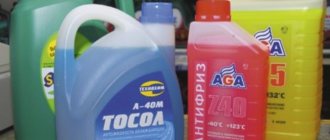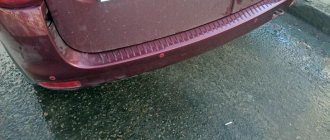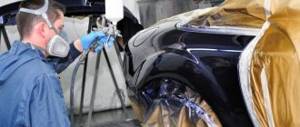- 1. Is it necessary to change the color if the car is covered with film? 1.1. What if less than 30 or 50%?
- 1.2. If the car became multi-colored?
- 3.1. Do I need to show the car?
- 4.1. Is it possible to avoid responsibility?
Wrapping a car with film does not actually change the color. After all, the main body color remains intact. But does the 2020 legislation formally require a color change? We provide complete, current and reliable information with reference to official laws in this article. We will also tell you in what cases re-registration with the traffic police is not required, how much it all costs, including through State Services, and what will happen for violating the obligation to make changes to the registration data of the vehicle.
Is it necessary to change the color if the car is covered with film?
Yes. But only if the main color actually changes.
Despite the fact that color replacement is technically carried out by painting the car - specifically with the paint of its body, on the road, of course, no one will figure out how the color of your car was changed.
- Article 11 of the Federal Law on Vehicle Registration regulates that the color of the car relates to the registration data, and this is natural, since it is indicated in the PTS and the registration certificate.
- In turn, paragraph 51 of the Government of the Russian Federation No. 1764 prescribes that if changes are made to the registration data, registration of these changes is necessary, therefore re-registration of the color of the car when covering with film is mandatory.
But a certain subtlety should be taken into account - car documents often indicate a shade that does not exactly match the color of the car. For example, the car is beige, but in the STS it is written as golden, in fact the color is azure, and in the PTS it is blue or light blue.
You will also be interested in:
- When and how to properly register a color change with the traffic police and how much is the state duty?
- Is it possible to drive under a purchase and sale agreement without a title?
- How to file a complaint and restore the registration of a car if it was terminated by the State Traffic Safety Inspectorate?
If, as a result of covering with film, the color changes insignificantly and corresponds to what is indicated in the documents, then there is no need to officially make changes. Here you need to understand that the traffic police inspector who stops you on the road establishes that the actual and reflected shade in the documents match. For example, you had an emerald-colored car, but the documents indicate green, you pasted a light green film - in this case, for the traffic police, the color remained green, so there is no need to make changes to change the color at the traffic police in 2020.
But in all other cases, re-registration of changing the shade of the car must be done. More examples: the car was red - it became blue, it was white - it became black, it was black - it became gray, and so on.
What if less than 30 or 50%?
There is a fairly old myth that if the main color of the car has not changed, then there is no need to make changes to the documents. Moreover, some say that after gluing the film, 30% of the shade indicated in the documents should be preserved, and others say about half.
But both of these meanings are not true. Previously, indeed, there was a rule of law that prescribed the percentage of the primary color to the additional one, in which there was no need to officially change it. However, in 2020, the corresponding norm is outdated, and you will not find such figures in the current legislation.
If the car became multi-colored?
In addition to the specific shades of the car body, the documents also indicate the so-called “mixed” color. This is exactly the case when a car consists of several shades, when it is impossible to recognize any of them as the main one in order to indicate it specifically in the PTS. In such cases, when registering, they write a mixed color.
If you previously had a specific color as your main color, but you covered your car with multi-colored films, then you officially need to make a change, as a result of which such a mixed color will be written into your documents.
Is it necessary to change the color of the PTS after pasting?
Sometimes, applying textured or colored car film can radically change the appearance of your car. And although these changes are temporary and you can always remove the coating and return to the original paint, many of our clients have a question: do they need to change the color in the PTS? Let's consider this issue from a legal point of view.
So, what should you do if you have been wanting to change the color of your car for a long time, or you are attracted to tuning with a fashionable film with a carbon effect. First of all, you should take into account that for the traffic police, wrapping a film is equivalent to painting a car, and if the color of the film differs from the original color of the car by more than 30%, then you will have to make changes to the vehicle’s passport. That is, according to the rules, owners of a red car can choose only shades of this range (cherry, coral, burgundy, etc.) However, this rule has a number of nuances, thanks to which you can safely glue the film you like and not worry about attracting attention valiant law enforcement officers.
Firstly, the color of the car is often indicated ambiguously in documents. For example, few people will be able to immediately distinguish the colors Baltic, aquamarine, lagoon and azure, although in fact they are all different shades of blue. And the colors of the film itself are difficult to describe, and owners of cars wrapped in, for example, a red-violet chameleon with a chrome effect don’t have to worry about the fact that their title is listed as one of the standard colors.
Secondly, with partial pasting, you are not required to change the color in the passport. Therefore, you can safely cover the hood, trunk or roof with film and drive for your pleasure. In addition, the car can always be covered with glossy, matte, carbon, matrix or other textured film, so that its color is close to the one listed on the title.
One of the popular ways to avoid a fine of 300 rubles. for untimely making changes to the PTS is knowledge of the simple rule that “after changing the color of the car, its owner is given 10 days to make changes to the registration documents.” And to the traffic inspector’s question about why you still haven’t changed the color on your passport, you can always say that you covered the car 5 days ago and were literally going to go to the traffic police station tomorrow.
If you are a law-abiding citizen and want to add a color change to the PTS, then this procedure will not take much time.
- At the place of registration of the vehicle, we provide our passport, PTS, and vehicle registration certificate.
- Fill out the application in the prescribed form.
- You provide the car for inspection by a traffic police inspector.
- You receive a receipt for payment of the state fee of 500 rubles. and pay for it at the nearest Sberbank terminal.
- You will receive a new vehicle registration certificate and your PTS, which will contain a note indicating that the color of the car has been changed.
So the choice is yours, but as practice shows, traffic police officers very rarely pay attention to the discrepancy between the color of a car covered with film. After all, in fact, the color of the car remains the same. And given the ten-day period for changing your passport, you don’t have to worry about finding yourself in the attention of overly vigilant inspectors.
How much does it cost?
The procedure for changing the color at the traffic police is free, but to update the documents you will need to pay state fees. And you will have to change two documents:
- PTS - they will make a change to this document with a new color of film,
- certificate of registration (CTC) – this parameter is also indicated here.
Accordingly, you will need to pay 2 fees before registration:
- 500 rubles for issuing a new certificate,
- 350 rubles for changing the PTS (unless you have run out of space for new entries, you will need to get a duplicate passport - this already costs 800 rubles).
Please note that if you pay state fees through the State Services portal when submitting an application, you will be given a 30% discount, and the total amount will thus be not 850, but 595 rubles.
What are the rules for changing the color of a car?
On the one hand, the use of vinyl film does not change the color of the car body - the film can be removed at any time. But from the point of view of the law, everything is a little different: if the film covers more than 30% of the body, then information about this must be included in the vehicle passport.
This procedure requires both time and money. Changes to the PTS occur only with a personal visit to the traffic police department. In this case, the driver must pay a fee of 350 rubles.
How to make changes?
This can be done, as we mentioned above, through State Services, as well as by personal visit to a convenient registration department of the traffic police. But there is an important subtlety - a personal visit can in fact be very difficult due to the established practice of the traffic police - either the coupons for the queue are running out, or you may be outright verbally denied registration.
When submitting an application through State Services, you will still have to come to the office by car later. To sign up, go to the appropriate section on the official website of the State Services, carefully read the instructions and procedure for providing the color replacement service and click on the “Get service” button.
As a result, you will be given a simple form where you need to fill in information about you and the car in order, select the traffic police department that is convenient for you, the date and time of your visit from the list of free ones, and arrive at the chosen time.
Do I need to show the car?
Yes. As regulated by Article 15 of the above-mentioned Federal Law, color change is the basis for inspection when changing the registration data of a vehicle.
What happens if you don’t re-register?
Nothing if you are not going to drive a car that is covered. Otherwise, the Code of Administrative Offenses of the Russian Federation provides for 2 sanctions for this:
- if you do not include in the documents a change in the color of the car, then at the first stop there will be a fine of 500-800 rubles under Part 1 of Article 12.1 of the Administrative Code,
- for a repeated violation within a year (after full payment of the first fine), you will be subject to Part 1.1 of the same article of the Code with deprivation of rights for 1-3 months or a fine of 5 thousand rubles.
Something else useful for you:
- Is it possible and how to buy a credit car correctly?
- Is it possible to buy a car on “perpetual registration” with a registration ban and what are the consequences of this?
- How to sign up to register a car with the traffic police and pay the fee through State Services?
Is it possible to avoid responsibility?
According to the law, no: if you did not fulfill your obligation and committed a violation, then the punishment is legal and natural.
But there is one loophole, which is the absence of an offense. Previously, the car owner was given 10 days to make changes after the occurrence of circumstances that required such a change.
However, in 2020 there is no such possibility. In the new version of the Federal Law On Registration, from January 1, 2020, you are simply obliged to change the color after covering it with color film (clause 4 of part 3 of article 8 of the law). That is, previously you could drive for 10 days with a car repainted or pasted over, and tell a traffic police officer who stopped you on the road that the color change happened just yesterday - because he doesn’t know the truth. And do this at least every day for an infinite amount of time.
Now you are obliged to immediately change the color at the traffic police. But here the essence does not change. If you say that you are just going to register, then the law does not have the right to issue you a fine in 2020. However, in practice, you may be required to print out an application at State Services, but this is illegal.
How to radically change the appearance without touching the body? All about vinyl films
We have already talked about protective and armor films that protect the body from minor damage and aggressive environments. Today we’ll talk about vinyl, which is used for completely different purposes: to radically change the appearance of a car without making structural changes to it. Below is the story of a specialist in this field, Sergei, whose services are used by ordinary car enthusiasts, motorsports athletes, and even commercial organizations:
Better with contrast
— If you see a matte car on the street, it is 90 percent film. As a rule, we are talking about a complete car wrap either in one color or with contrasting inserts. For example, as is the case with this Nissan GT-R, which is pictured: it will go from black to orange with some black elements. Although often there is simply a change in color or shade. Legalizing a color change is not difficult: you go through a body check, receive a new registration certificate - there are no special problems with this now.
Compared to painting, filming has its advantages. For example, in the event of an accident, an element can be replaced within a few hours. Replacing the film on one element will cost about the same money as repainting it: the front bumper costs more, since a lot of material is required, but the roof is cheaper. The most expensive parts are the front bumper and rear fender. At the same time, you get the color 100 percent. Usually the film is taken with a reserve, this reserve is stored.
Another good thing about film is that you can quickly change the color or shade, and, if necessary, return to the original version. The only drawback is that the palette itself is still limited; you cannot get a new shade by mixing colors.
If we talk about highlighting individual elements, then usually this is the roof, hood, spoiler, which are made in black matte, black gloss or carbon fiber. Recently, the “panoramic” roof has been very popular - we roll it up in black gloss, it looks like tinted glass. However, we try to approach all cars in a way that is tasteful; not every solution suits all cars.
Headlight tinting is quite popular. The film provides minimal protection, but armor film is better suited for front optics in this regard. The back is pasted over solely for the sake of aesthetic appearance, while the film practically does not reduce light transmittance. If you see very dark lights, this is probably varnish, because everything is clearly visible through the film.
It is also fashionable to cover individual elements in the interior - dashboard, door handles, trims. We do it in aluminum and carbon fiber, now we’ve started experimenting, adding graphics, contrasting inserts (red and black).
About materials and technologies
We work with manufacturers such as 3M and Arlon. In Belarus, especially in the regions, there are a lot of different “China” - it’s better not to use it. Why? The difference is, firstly, in the colors. High-quality films even look different—better, “more expensive.” But the most important difference is adhesion. Chinese films either do not stick at all, which makes it impossible to make any complex element, or, on the contrary, they stick so that they cannot be removed. The advantage of expensive film is that after a few years it can be dismantled without any consequences. It's hard to get a cheap one.
Here the plotter is not used: there are no patterns, the material for the element is not cut. The footage is taken and applied to the car. All excess is cut off and the edges are folded. As a rule, partial disassembly of the body is required: bumpers, handles, mirrors are removed.
The same story with small elements. Their pasting seems simple only at first glance. For example, in order to change the color of the mirror housing, it was necessary to dismantle it, and to do this, the car doors had to be disassembled.
The film is designed to last for a long time and lasts about 5-8 years. After removing it, the body is in the same condition as it was before. When pasting and removing the film, the car is not scratched. On the contrary, the paintwork is preserved. The film protects the body well from aggressive reagents. Partly also against chips, but not as effective as the armor one.
The cost depends on the class of the car, its size, as well as the choice of film manufacturer. Anything under $1000 means using cheap film. For that kind of money, you can’t completely cover a car with high-quality materials. Even with simpler manufacturers, a full wrap will cost from $1,300 for a small car and from $1,500 if premium-segment films are used. The maximum cost is $2500-3000. If there is an additional body kit, for example an M or AMG package, then the cost will increase by 10-20 percent. Openings are also paid for separately, but in principle, pasters suggest doing them only in compartments.
Human factor
The film is applied only with heating, it stretches well, but here it is important to do everything with knowledge and understanding that it does not stretch indefinitely. The qualifications of the master affect the result. The level of a specialist is usually confirmed by a certificate, for example, from 3M. Feel free to request such documents from the performers! It’s not so rare that you have to redo it for unfortunate pasters.
Typical problems of shoddy work? Specialists who rarely work with expensive cars and films often damage them, from the moment of disassembly to pasting. For example, there is a special tape that is glued over the body, then a film is glued onto it. When the tape is pulled out, it carefully cuts the film where it is needed. But such tape is expensive, so not everyone uses it - they cut the film with a knife along the body, often damaging the paintwork. Of course, a knife can cut well and accurately. But it happens that serious incisions are made. So, before you take on the work yourself, you should think three times whether you will be able to do everything correctly and accurately.
Although, unlike protective film, here you can still try to do everything yourself. Of course, it’s difficult to count on a perfect result the first time; in addition, you will need tools and materials: a hair dryer, a set of knives and blades, clay, etc. But with some skill it can work out.
Flight of fancy
We work with graphics, from design development to complete wrapping in expensive exclusive colors, which few others can offer. Creative work is already underway here with the body, color combinations...
By the way, we also work with commercial vehicles. Branding is very popular among organizations: they can advertise themselves on board their cars. We are not talking about the banal application of a name and telephone numbers: a design, a logo are developed, the company’s corporate colors are played out - the result should be an unusual, but integral image that attracts attention and is remembered. Well, what technologies are used?
Vinylography (drawings on film) is a kind of analogue of airbrushing, which is cheaper than painting. The image is created on a computer (for this there is a whole staff of artists who work in various programs), printed on film and laminated. The benefits are still the same. If the car is damaged, the drawing is easy to restore: the file is saved on the computer, so restoration work is carried out quickly and easily. And if you are tired of the old image, you can change it to a new one.
An important point is that high-quality cast film must be used. To save money, some use regular advertising film, which is not intended for such things. Cheap material will eventually crack at the seams, peel off, etc.
Another approach to creating an individual appearance is contrasting pasting using various inserts and geometric shapes. This type of wrap is most often used in sports cars.
The created layout is implemented either as vinylography (the design is made on printed film and applied to the car), or done manually: using a plotter, elements are cut out from colored film and applied to the car. In other words, we take blue, green, red films and make graphics from them, laying them end-to-end or one on top of the other.
If individual elements are glued end-to-end, it is important to take into account the fact that over time the films shrink. And if with an expensive film we are talking about fractions of a millimeter, then a cheap one can easily “shrink” by a centimeter. Unfortunately, customers often choose based on cost, without paying attention to quality.
Our verdict
Completely covering with film is not a cheap pleasure, especially when using high-quality materials. But everything is learned by comparison: customizing the appearance with the help of branded tuning packages (thresholds, “skirts” and spoilers) will cost even more. At the same time, vinyl allows you not only to change the color of the car, but to create a fundamentally different image, and it also provides paint protection. Finally, you can limit yourself to only individual elements. It will be cheaper, and if implemented correctly, it can be no less impressive than a full wrap.
Ivan KRISHKEVICH ABW.BY











